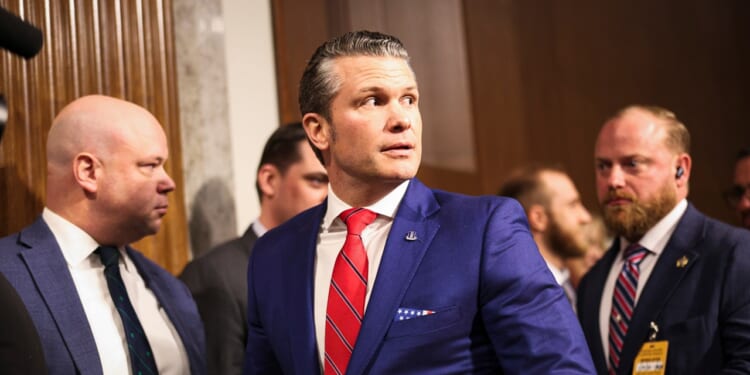Secretary of Defense Pete Hegseth has called for stricter enforcement of fitness standards—though many of the military’s most important roles have little direct connection to physical fitness.
In his recent “pep talk” with senior United States military leaders at Marine Corps Base Quantico last month, Secretary of Defense Pete Hegseth called for a return to a “warrior ethos,” and took direct aim at “fat” soldiers—including those with stars on their shoulders.
“If the Secretary of War can do regular, hard PT [physical training], so can every member of our joint force. Frankly, it’s tiring to look out at combat formations, or really any formation, and see fat troops,” Hegseth said. “Likewise, it’s completely unacceptable to see fat generals and admirals in the halls of the Pentagon and leading commands around the country and the world. It’s a bad look. It is bad, and it’s not who we are.”
The comments from the secretary were quickly met with praise from Republican lawmakers and MAGA supporters on social media, who felt it was past time the United States military once again became a lean, mean, fighting machine.
Is the US Military Too Fat?
There were many, including some on the right, who bluntly countered that Hegseth’s focus on fitness is entirely out of touch with the realities of the 21st century.
Laura McTaggart, a United States Navy veteran and management consultant, wrote for WBUR, Boston’s NPR affiliate, that she believed Hegseth doesn’t understand the complexities of the modern military.
“Unequal fitness standards were a major theme of Hegseth’s speech, but fitness standards are not the best indicator of combat readiness. When I showed up for a midwatch (the watch period from midnight to 0400 hours), the officer I relieved didn’t care how fast I could run — he cared that I could quickly understand the turnover details and drive the ship safely for the next four hours,” McTaggart explained of her time on the Nimitz-class nuclear-powered supercarrier USS Dwight D. Eisenhower (CVN-69).
She added that during her time on the now-retired Knox-class frigate USS Truett (FF-1095), the daily PT that Hegseth called for would have been complicated for the crew of more than 200 sailors to carry out.
“In 1993, our ‘gym’ was a single exercise bike in the empty helicopter hangar. That hangar was also where we stored our garbage while at sea,” McTaggart noted.
Beyond a lack of facility, there would likely be a lack of time.
All branches of the United States military indeed exceeded recruiting goals for a second year in a row for Fiscal Year 2025 (FY25). Some conservative commentators have suggested the surge in recruiting came because of Trump’s reelection and Hegseth’s vow to end “wokeness” within the DoD. However, Fiscal Year 2024 (FY24), which ended on September 30, 2024 during the presidency of Joe Biden, also saw all the services meet their goals after a few years of struggles.
It wasn’t DEI or “dudes in dresses” in the ranks—topics Hegseth touched on in his speech—that were the problem. Unemployment reached record lows, and young people today have more opportunities. Fewer are interested in a career in the military, and many who might have considered enlisting didn’t meet the physical standards. It could be argued that Hegseth’s fitness goals will solve the latter problem—but they likely will not.
Supporters of the secretary suggest he really means “combat troops,” i.e. frontline soldiers, rather than those involved in administrative roles. But if recruits cannot get into the service due to high fitness standards, the service won’t get them fit later.
Moreover, that in turn could mean the future drone operators, psyops warriors, cyber experts, and others won’t be in the ranks. Those types of individuals could be needed as much, if not more, than the front-line troops that Hegseth likes to work out with—and their physical fitness has relatively little to do with their skills in specialized roles.
“In Hegseth’s fantasy military, every war is a ground war, and every ground war is won by the team that does the most pull-ups. His one-dimensional view of the military gives him a one-dimensional view of combat readiness,” McTaggart continued.
National Guardsmen Don’t Always Have Fitness Resources
Just weeks after his speech, images also went viral online of stocky Texas National Guard personnel who were deployed to Chicago as part of the Trump administration’s crackdown on illegal immigration. It was an example of what Hegseth might have described as a “bad look.”
Soon after the photos made the rounds, numerous individuals were recalled. For supporters of Hegseth, it was “mission accomplished.” Fitter troops, who exude the “warrior ethos,” were deployed instead.
But this, too, fails to address an issue. National Guard troops aren’t required to do the “regular, hard PT” that Hegseth takes on. In fact, many lack the opportunity to do so.
“Part-time military members lack access to fitness resources even though they’re held to the same standards as their active duty peers,” USA Today explained. “In many cases, these troops are balancing two or even three jobs. And, unlike full-time force members, they don’t receive disability benefits if they are injured while training off-duty.”
The report added that those in the reserves and the National Guard spend just a few days a month in uniform, and many live far from their units.
“Even if their small military facilities, colloquially known as armories, had physically centralized fitness resources and equipment, many would be unable to take advantage of them,” USA Today added.
There are simply not enough hours in the day, and after work, family obligations don’t leave time to get fit. And as the report also highlighted, if a National Guard or reserve member is injured and it doesn’t occur during their time in uniform, they won’t receive the same benefits as full-time personnel.
All of that results in some portly part-time troops, like the ones seen in Chicago. It may not be a good look—but the alternative could be fewer personnel available to step up when needed!
About the Author: Peter Suciu
Peter Suciu has contributed over 3,200 published pieces to more than four dozen magazines and websites over a 30-year career in journalism. He regularly writes about military hardware, firearms history, cybersecurity, politics, and international affairs. Peter is also a contributing writer for Forbes and Clearance Jobs. He is based in Michigan. You can follow him on Twitter: @PeterSuciu. You can email the author: [email protected].
Image: Shutterstock / Joshua Sukoff.

















